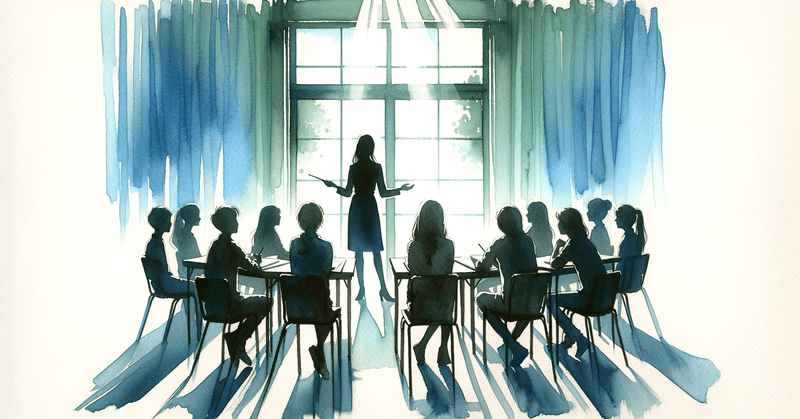
「教えること」と「教えないこと」のハーモニー。| The Harmony of "Teaching" and "Not Teaching"
コーチングは、教えることではなく、ティーチングが、教えることです。教えることには知識が必要ですが、コーチングには知識が必ずしも必要ではありません。コーチングの少しの知識があれば、誰でも何でもコーチすることができます。ですから、コーチングを試したり、知っていることを誰かに教えたりすることを恐れないでください。ただ、その違いを認識しておくことが重要です。
Coaching is not teaching, teaching is teaching. Teaching requires knowledge, coaching doesn’t. Anyone can coach anything with a little knowledge of coaching. So don’t be afraid to try coaching, or to teach someone, something. You know about, but be aware of the difference.

18年間コーチとして活動してきた私は、常にクライアントに問いかけ、彼らが自分自身の答えを見つけるよう促してきました。しかし最近、姪への数学や英語の指導、傾聴講座の開始、また、以前の部下からの相談への対応といった形で「教える」ことへの扉が再び開かれました。これまで「教えない」スタンスを貫いてきた私ですが、この新たな局面はまさに宇宙からの導きのように感じられます。
Having worked as a coach for 18 years, I have always encouraged my clients to question themselves and find their own answers. However, recently, the door to "teaching" has been reopened to me in the form of tutoring my niece in math and English, starting a listening course, and responding to consultations from former subordinates. Although I have maintained a stance of "not teaching" up until now, this new phase feels like guidance from the universe.
私が「教える」という挑戦に最初に直面したのは、アパレル店長を務めていた時です。アパレル業界の経験がないにも関わらず、マネジメントの経験を理由に店長に任命されました。しかし、部下に教えることができないという状況は非常に居心地が悪かったです。何一つ、「教えられない」からです。そんな中でコーチングに出会い、アパレルの知識がなくても、相手に問いかけ、彼らから答えを引き出すことができれば、具体的なアクションやモチベーションを促すことができることを学びました。コーチングスキルには大きな期待を寄せ、期待以上の結果につながりました。それから自然と、コーチとして活動するようになりました。
The first time I faced the challenge of "teaching" was when I served as a manager in an apparel store. Despite having no experience in the apparel industry, I was appointed manager due to my experience in management. However, the situation of not being able to teach my subordinates was very uncomfortable because I couldn't teach anything. It was during this time that I discovered coaching and learned that even without knowledge of apparel, by asking questions and drawing out answers from others, I could encourage specific actions and motivation. I had great expectations for coaching skills, and they led to results beyond my expectations. Naturally, this led me to start working as a coach.
独立してからは、「独立の方法を教えてほしい」と求める人が増え、コーチでありながら教える必要に迫られることが心苦しい時もありました。「コンサルタント」と名乗ったほうが良いのだろうか? と真剣に悩んでいました。アパレルでの成功体験を活かしてほしいとの依頼もあり、こちらは、コンサルタントとしての役割を果たす中で、教えることの難しさも経験しました。結局、2社ともクビになってしまったのです。
After becoming independent, the number of people asking me to teach them how to become independent increased, and there were times when it was distressing to have to teach despite being a coach. I seriously wondered if I should just call myself a consultant. I was also asked to leverage my successful experiences in the apparel industry, and in fulfilling my role as a consultant, I experienced the challenges of teaching. Ultimately, I was let go by both companies.
「教えること」と「教えないこと」の間で葛藤しながらも、最終的には「コーチングだけをする」と決意しました。しかし、時間が経つにつれ、「教える」機会が再び訪れ、教育とコーチングのスキルを組み合わせることの価値を再認識しました。コーチングの技術、特に傾聴や質問を通じて思考を刺激し、人々を自己発見に導く力は、教育の場でも非常に重要です。これらのスキルによって、学習プロセスに深みを加え、パーソナライズされた学習経験を提供することができることを実感しています。
Despite my conflict between "teaching" and "not teaching," I eventually decided to focus solely on coaching. However, as time passed, opportunities to teach presented themselves again, leading me to reacknowledge the value of combining educational and coaching skills. The techniques of coaching, especially stimulating thought through listening and questioning and guiding people to self-discovery, are extremely important in educational contexts as well. I have come to realize that these skills can add depth to the learning process and provide personalized learning experiences.
また、「教えられない」と感じる瞬間にも、コーチングスキルが役立ち、学習者が自己効力感を高めるきっかけとなり得ます。例えば、私がピタゴラスの定理を忘れていたとしても、姪に数学への情熱を伝えることができました。相手の既存の知識や興味から出発点を見つけ、質問を通じて彼女の学習プロセスをサポートすることで、共に成長し、達成感を感じることができます。
Even in moments when I felt unable to teach, coaching skills proved to be beneficial, serving as a catalyst for learners to enhance their self-efficacy. For instance, even though I had forgotten Pythagoras' theorem, I was able to instill a passion for mathematics in my niece. By identifying a starting point based on her existing knowledge and interests and supporting her learning process through questioning, we were able to grow together and experience a sense of accomplishment.
傾聴講座では、コーチングの技術を活用しながら、参加者と対話を深め、互いに学び合う環境を作り出しています。これらの経験は、「教える」と「教えない」の組み合わせが、学習者の可能性を最大限に引き出し、学びの真髄を形成することを確信させてくれました。
In my listening courses, I utilize coaching techniques to deepen dialogues with participants, creating an environment where we can learn from each other. These experiences have convinced me that combining "teaching" and "not teaching" can maximize learners' potential and form the essence of learning.
伝統的な「教える」方法と、自己発見を促す「教えない」スタイル。これら二つの教育法は表面上は対立しているように見えますが、実際には相互に補完し合い、学習体験をさらに豊かにすることができます。これらを組み合わせることで、学習者は自分自身の可能性を最大限に引き出すことができます。提供するのは単なる知識ではなく、自己発見の旅そのものです。このアプローチを通じて、私たちは互いに学び、成長し、無限の可能性を探求することができるのです。
The traditional method of "teaching" and the "non-teaching" style that promotes self-discovery may seem to be in opposition at first glance. However, in reality, they complement each other and can enhance the learning experience even further. By integrating these approaches, learners can maximize their own potential. What is provided is not merely knowledge, but a journey of self-discovery itself. Through this approach, we can learn and grow together, exploring infinite possibilities.
■編集後記
コーチングを極めるために、「教えない」ことを守り通してきたことを思い出しました。教えれば済みそうなところを、教えないで、自身に気づかせること。あなたなら、どうやりますか?
この記事が気に入ったらサポートをしてみませんか?
